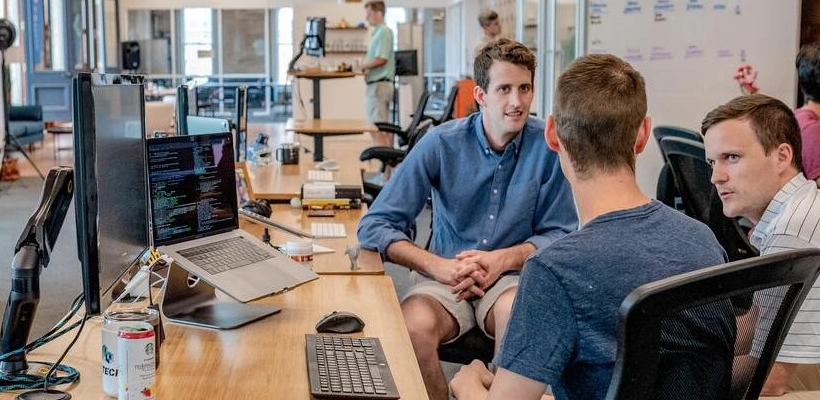Behavioural change is not always easy to invoke or attain. In this interview, we had the opportunity to speak to the expert in her field Fiona Cameron, who will discuss how behavioural changes are occurring within businesses and how this change can be created and managed. Fiona is the director of the Organisational Development Company Sticky Change. Sticky Change provides consultancy, team facilitation, training and one on one coaching to inspire professionals to embark on a positive behavioural change journey. To change their behaviour for the better. By identifying healthy practices to maintain and unhealthy practices to avoid, Sticky Change helps professionals, teams and companies be their very best selves, for the benefit of their business and themselves.
Could you start by telling me a little bit more about yourself and how your career evolved into what it is today?
I did my degree in Microbiology but soon decided that working in a lab wasn’t for me. Hence, I went back to University in Edinburgh and did an MBA, after which I moved jobs fairly quickly. The job that really interested and engaged me was working in learning and development. I, therefore, moved into a learning and development role for a small organisation. From there I became interested in change management. I spent a couple of years working in central Eastern Europe at a fascinating time when the Berlin wall had just come down.
Afterwards, I worked for Accenture as a change management consultant, before moving into United Utilities in the North West of England. In this role, I was managing a huge culture change programme with around 17,000 employees. Having stated for ages that I should set up my own business, the time was finally right! So, in 2004, together with 2 colleagues we created Sticky Change. We very quickly came up with our tagline which was about helping organisations facilitate change. So the name Sticky Change stuck, and it has worked really well for us. The name works well due to its double meaning – achieving change is sticky and you’re trying to make change stick.
Could you tell me a bit more specifically about Sticky Change and the work it does?
Our tagline now is to inspire people to do things differently. We work at 3 different levels. Firstly we deliver one to one executive coaching, helping people to manage personal behavioural change. Secondly, we work with teams, undertaking team development and team coaching, particularly using a model called the 5 behaviours of a cohesive team. The author Patrick Lencioni wrote a book called ‘The 5 Dysfunctions of a Team’, and there’s a psychometric tool based on that which is one of the best team models around. It helps teams overcome their dysfunctions and become more effective and high performing. Thirdly we work at an organisational level delivering training, in a variety of subjects such as managing change, leadership skills and coaching, and we facilitate culture change in big organisational development programmes.
How would you say this epidemic has affected businesses in invoking positive behavioural change?
At the moment Sticky Change is working on an organisational development programme, focusing on the behaviours that the organisation wants to adopt so that everybody can thrive and be at their best. Doing this around the time of covid has proved very interesting as a lot of the conversations we’re having are about what has worked well for people in lockdown. For example, because employees are working remotely, and managers can no longer sit next to them and micromanage them, they are starting to realise that people actually can be trusted. It’s a huge learning process for a lot of managers who have spent their lives being very controlling and not trusting their people to deliver. The statistics show that productivity has improved since lockdown. So managers are realising their people can be trusted and will deliver even when out of their sight.
Other behavioural changes that are occurring are that leaders are really caring about their employees’ well being a lot more. Managers are checking in regarding their employees physical and mental health and making sure their staff are coping. However, there’s a danger that these changes in attitudes will get lost again. During a pandemic, it’s deemed okay to admit you are not coping. But the reality of the situation is that there are people not coping all the time, not just when there’s a pandemic going on. So it’s really important that managers don’t lose that.
What kind of work do you do to inspire behavioural change and how do you ensure that the change sticks?
HR and Transformation professionals are our primary clientele. Say a team wants to transform an organisation, they’ll bring us in to do a particular piece of work and we will work with them to shape what that looks like. We work in collaboration with our clients and always co-create the solutions. So the part about how to make change stick: if someone attends a training course and that’s the only intervention they make, the chances of them changing their behaviours are very small. We, therefore, encourage our clients to take a holistic approach.
Say, for example, you are learning a new skill. We would encourage you to have a conversation with your manager before going on a course. You want to see what you want to get out of it, what does he/she want you to get out of it, how are you going to change, what will you do differently. Then you go on the course, you go back and have another conversation regarding 3 specific things you’re going to change and you put those into your development plan. Then you have a regular conversation with your manager about how you are managing those changes and measure your progress.
Additionally, we would also recommend that the organisation consider establishing Action Learning Sets and/or a buddy system for the course participants – so they check in with each other regularly and share their learning. If you do all this, then you are much more likely to sustain the desired changes in behaviour rather than through just attending a one-day training course. We, therefore, recommend clients facilitate development programmes and actively engage the organisation, particularly the participants’ managers in the process. If you want to sustain behavioural change it needs to be more than just a training event. It’s about turning the behavioural change into a habit.
This is important as it is very difficult to change habits. Our brains have very well established neural pathways that mean we do things we are accustomed to at speed. When you are changing behaviours you have to ‘turn off’ an existing neural pathway and create a new one, which takes time and lots of repetition! Also, you’re much more likely to make change stick if someone else is holding you to account and giving you recognition when you are changing your behaviour, such as your manager and/or your colleagues.

What experience have you had with HR software?
One example of my experience (or lack of) with HR software was through a project that I took on with a funeral company. It had grown by taking over lots of family-run businesses and they had a very small HR team, but they had no data at all. They had no idea what their attrition rate was, no idea what their sickness rate was, they didn’t know how many people were being promoted internally, there were no performance management processes etc. And there was absolutely no central data. One practice, for example, when they wanted new staff, is that they would literally just put a sign on the door of the Funeral Parlour. The funeral company would have significantly benefitted from a recruitment tracking system, particularly to focus on increasing diversity. So many of the businesses they took over were family-run and there was no concept of the benefit of a diverse workforce. Both the Exec and the senior Ops teams were all white men, although 1 woman was appointed into the senior Ops team whilst I was working with them. At the time I started they had just appointed a new Head of HR and regional HR Business Partners and one of the first things they were doing was putting in place the systems to provide them with the data they need to do their jobs properly.
Obtaining the data started to demonstrate the benefit of doing things properly, thus gaining buy-in from their operational colleagues. They now have access to evidence which enables them to go to the Board and talk about why the HR initiatives are important, for example, they can now demonstrate how much it costs their organisation when they lose a member of staff and talk about the need for excellent management skills. It was a wonderful company to work with, the customer service is just amazing, and now they are starting to put the appropriate systems in place it will be even better.
If managers can see the evidence from the data collected, then they can invoke proper change and change their way of working through behavioural changes. They needed that data to manage performance well and look after their people and support them because the cost of not doing that is huge. Also when you’re trying to get people to change, they are much more likely to change when they have got measures behind them- so without any people metrics like performance management, it’s very difficult to get people to buy into making the changes that we’re talking about.
What do you think are the effects of having HR software in space within businesses?
HR professionals can dedicate more of their time to making changes to their business to benefit the company. This is down to two main reasons: firstly they don’t have to manually work out what the data is, so they’re saving time that way. Secondly, because they are able to use the data to give them evidence for why these changes are required in order to get support – and importantly finance – from the Board or Executive team
With the projects you've fronted in the past, have the majority of the businesses used HR software instead of carrying out these processes manually?
Yes. However, I have to say that quite a few of my clients don’t have any proper performance management processes in place, which shocks me in 2020. But yes I think the majority have.
Factorial's performance management system
Factorial’s performance management feature gives you a sense of your company’s rhythm whilst facilitating you in making important decisions based on qualitative data. It enables you to run performance review cycles, by choosing the best performance review model for your company; we support the most frequently used evaluation methods. Factorial offers complete flexibility, you can implement your own model or use our example. It conducts your performance reviews automatically. Additionally, Factorial allows you to evaluate employee performance from the same place the rest of your HR data is stored, as well as being able to track your company’s performance management with custom reports.


